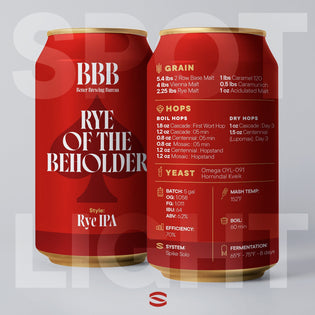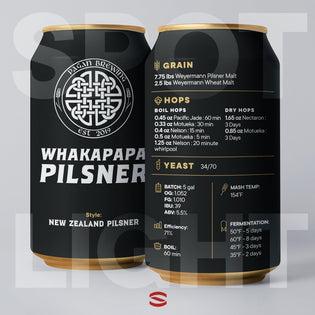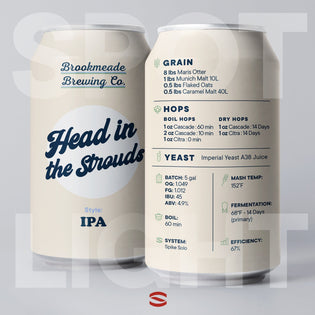
The Brewer: Robert Jesus
A buddy and I discovered a local brew club TC•HOPS at a brewfest in Visalia, CA in 2011. Subsequently, we learned of several craft beer pubs in town. We started brewing extract kits together and soon after moved onto all-grain brewing.

In 2012, we planted 60’ of a variety of hops vines that grow in zone 9. Mind you, none of our favorites can handle our Summer season.

Initially, I brewed on a outdoor propane gas burner with a 7-gallon kettle and an Igloo mash tun. Three years ago, I purchased a 20 gallon 220v Spike Solo. I recently won 1st place in a local homebrew completion at House of Pendragon brewery with my Lofty Goal IPA.
We came up with the name Hop Altar from the fact we occasionally have weddings in the back of our property by the hop vines—plus the fact we brew beer here!
It's almost a double entendre in that 1) During a wedding here, the wedding party is surrounded with Hops while they’re at the “Altar" and 2) Hops "Alter" the flavor of beer.

Lofty Goal will be brewed and canned on House of Pendragon’s 10 bbl system, but better still, my son, Alex, took second place with his Hazy IPA and there’s talk of them brewing his as well!

Photo: Robert and his son, Alex.
The Beer: IPA
The Lofty Goal name evolved from drinking GOAL Brewing's fabulous "Rolling on Wats" Double IPA at the 2024 Bistro Double IPA festival.
While this second iteration of this recipe deviated from the Rolling in Wats, Mosaic / Nelson hop schedule, it remains a deliciously clean and hoppy new school IPA.

- For Lofty Goal, you don't boil hops—whirlpool and dry hop only.
- Add 2 Whirlfloc tablets in the boil.
- 3 Day Cold Crash = Day 2 dump trub and add gelatin.
- Day 3 dump trub and closed transfer into CO2 purged kegs.

The Recipe: Lofty Goal IPA

INGREDIENTS
GRAIN
- 16 lbs 2-row Malt
- 16 lbs Pilsner Malt
- 1.5 lbs Chit Malt
- 1 lbs Rye Malt
- 0.75 lbs Acidulated Malt
- 0.5 lbs Corn Sugar
HOPS
- Boil hops: 1 oz Citra Cryo- Whirlpool
- Boil hops: 1 oz HBC 586- Whirlpool
- Boil hops: 0.35 oz Citra Incognito- Whirlpool
- Dry hops: 7 oz. Citra Cryo - Day 7
- Dry hops: 7 oz. HBC 586 - Day 7
- Dry hops: 3 oz. Nelson Sauvin Cryo - Day 7
YEAST
- Omega Star Party / OYL-404 / 2x

INSTRUCTIONS
BATCH SIZE: 10 gal
OG: 1.074
FG: 1.016
IBU: 0
ABV: 7.6%
EFFICIENCY: 70%
MASH TEMP: 145 ºF- 1 hour / 155 ºF- 30 min / 168 ºF- 10 min
BOIL: 60 min
FERMENTATION: 68ºF - 10 days
SYSTEM: Spike Solo 20g
Cheers,
Robert Jesus - Hop Altar Brewing
Spike Summarizes: All Things IPA
What is an IPA?
India Pale Ales (IPAs) have surged in popularity as craft beer favorites in recent years. Recognized for their bold and bitter taste, IPAs derive these distinctive flavors from hops. These hops are generally more potent than those found in other beer styles, resulting in a one-of-a-kind flavor profile. With alcohol content typically ranging from 4-7% ABV, IPAs stand out from the crowd.
You'll find a variety of IPA subcategories, including West Coast, East Coast, Session, Belgian, and Fruited IPAs, just to name a few. If you're on the hunt for a brew with a powerful taste and a pronounced hop character, IPAs are the way to go!
Why are IPAs popular?
Renowned for their bold and bitter flavors, IPAs boast a "hop forward" taste, setting them apart from other beers. The citrusy, floral, and herbal hops contribute to their distinct flavor profile.
What does an IPA taste like?
Depending on the IPA variety, you might even detect hints of tropical fruit, citrus, pine, and herbal notes in its flavor profile.
What is the History of IPAs?
Originating in 19th-century England, the India Pale Ale (IPA) was initially crafted to supply beer to troops stationed in India. Its high alcohol and hop content helped preserve the beer during long voyages, and it soon gained popularity in England before spreading worldwide as a cherished beer style.
Contemporary IPAs come in various styles and flavors, from traditional English IPAs to modern American ones. Hops can range from light and floral to intensely bitter, while alcohol content varies from light to strong. Brewers often experiment with diverse hop varieties and techniques to develop complex, unique brews.
How do I drink an IPA?
To fully appreciate an IPA, keep these tips in mind.
- Serve IPAs slightly colder than other beers to enhance the hop flavors and aromas, ensuring a more enjoyable experience.
- Pour the IPA slowly and in a circular motion to create a nice head, locking in flavor and aroma. This also produces an attractive lacing on the glass.
- When tasting an IPA, take a moment to savor the flavors and aromas. Sip slowly, allowing the beer to linger on your palate. Notice the hop flavors, aromas, and any other distinct characteristics. Observe how the bitterness evolves as the beer warms.
What should I pair with an IPA?
When pairing an IPA with food, keep in mind that its bitterness can overpower subtle flavors. It's best to match IPAs with bold dishes that can withstand the beer's hop-forward taste.
- Spicy cuisine like Mexican or Indian food pairs well with IPAs as the beer's hop bitterness cuts through the spice, while malt sweetness balances the heat. For a milder option, opt for a sweeter IPA like a Belgian or fruited one.
- Rich, savory dishes like a juicy steak or hearty stew also complement IPAs. The beer's bitterness cuts through the fat, and the malt sweetness balances the flavors. A West Coast or Double IPA works well in this pairing.
- For a lighter match, pair an IPA with a salad or seafood dish. A Session IPA or Lactose IPA, both having lower hop bitterness and malt sweetness, are suitable options.
- For a sweet pairing, consider a fruit-forward IPA like a Fruited or Sour IPA, which often contains fruit purees or juices, making them ideal for desserts and sweet dishes.
What ABV range is commonly associated with IPAs?
India Pale Ales typically have an ABV range of 5-7%, but this varies depending on the IPA type. West Coast IPAs generally feature higher ABV levels, between 6-7.5%, while Session IPAs have a lower range of 4-5.5% ABV. Double IPAs, also known as Imperial IPAs, are the strongest with an ABV of 7-10%.
It's important to remember that higher ABV levels result in more intense and bitter flavors due to the increased hops and malt used in the brewing process. If you prefer a stronger, more bitter beer, opt for an IPA with a higher ABV. Conversely, choose a lower ABV IPA for a milder, less bitter flavor.
What are the Types of IPA?
West Coast IPA
Characterized by its intense hop flavor and aroma, the West Coast IPA is a highly hopped beer with a pronounced bitterness and robust hop taste, balanced by a light malt profile.
With moderate to very high hop bitterness and alcohol content ranging from 5% to 10%, these beers are typically dry-hopped for added aroma and flavor. They are often unfiltered and hazy.
East Coast IPA
East Coast IPAs, distinguished by their moderate to high bitterness and less prominent malt profile compared to West Coast IPAs, feature a slightly sweeter taste and lower hop intensity.
With a light to medium body and a crisp finish, these IPAs are brewed using American hops East Coast IPAs may include fruit, wheat, or oats as adjunct ingredients, creating a more complex flavor profile.
Session IPA
Session IPAs, known for their lower alcohol content compared to traditional IPAs, are designed for extended consumption without becoming overwhelming.
With a lighter body and balanced flavor, this emphasizes the hop aroma and flavor rather than intense bitterness, showcasing citrusy, floral, and herbal notes.
British IPA
Originating in the United Kingdom in the late 1700s, British IPAs, or English IPAs, are recognized by their floral and fruity aroma, balanced malt flavor, and slightly bitter finish.
Typically brewed with traditional English hop varieties like Fuggles and Goldings, these beers showcase a light to medium body, a golden to amber hue, and an ABV of 4.5-6.5%.
British IPAs have a balanced flavor profile with mild to moderate bitterness, combining mild malt sweetness and moderate hop bitterness.
Lactose IPA Aka “Milkshake” IPA
The increasingly popular Lactose IPA, or "Milkshake" IPA, is a newer beer style in the craft beer scene. Brewed with lactose, a sugar derived from milk, it imparts a creamy, sweet flavor reminiscent of a milkshake.
This ingredient also contributes to a smooth, full-bodied texture. While various hops are used in brewing, the lactose sweetness balances out the hoppy bitterness, resulting in a complex and refreshing beer with a one-of-a-kind flavor profile.
Oat IPA
Oat IPAs are distinctive among other IPA styles due to their higher oat content, which lends a creamy, smooth mouthfeel.
With fruity, floral, and citrus notes, Oat IPAs are highly drinkable and often finish dry. This style is perfect for those seeking to experience the bold, bitter flavors of IPAs without feeling overwhelmed.
Belgian IPA
Belgian IPAs bring a distinct twist to the well-known India Pale Ale by incorporating Belgian yeast, which contributes a unique flavor. Typically lighter in color, these IPAs boast a pronounced floral and fruity aroma.
Often brewed with hops like Styrian Goldings, Saaz, and Hallertau, they exhibit a spicy and herbal taste. Though not as bitter as their traditional counterparts, they maintain a strong hop character and a satisfying, lingering finish.
Fruited IPA
Fruited IPAs have gained popularity in recent years, adding a unique twist to the classic IPA by incorporating various fruits. Commonly featuring pineapple, mango, passionfruit, and citrus, these beers can range from sweet to tart. The fruit addition introduces a slight acidity, which balances the hop bitterness.
Sour IPA
Sour IPAs, called "sour ales," have a distinct sour, tart, or acidic taste. Brewed with wild yeast strains, bacteria, and other microorganisms, they offer a unique flavor and aroma. Ranging from light and fruity to dark and intense, these beers generally have a lower alcohol content than traditional IPAs.
Brett IPA
Brett IPA, or Brettanomyces IPA, has gained popularity for its distinctive flavor profile, achieved by adding Brettanomyces yeast during fermentation.
This yeast generates a variety of unique flavor compounds, such as tropical fruit, citrus, earthy notes, and mild funkiness. Dry-hopping emphasizes the hop character and intensifies the bitterness.
Double IPA
Double IPAs, or Imperial IPAs, boast higher amounts of hops, malt, and alcohol than their traditional counterparts. These full-bodied beers offer a robust hop flavor and aroma, balanced by sweet maltiness and a lingering finish.
The increased alcohol content creates a smooth mouthfeel and pleasant warming sensation. Ideal for those seeking bolder, more complex flavors, Double IPAs cater to fans of stronger beers.
Black IPA
Black IPAs, or Cascadian Dark Ales, merge the hop-forward flavors of a classic IPA with the dark maltiness of stouts or porters. This creates a bold, bitter beer with rich, roasted undertones.
Brewed with dark malts like chocolate and black patent, along with hop varieties such as Cascade, Centennial, and Amarillo, Black IPAs boast a strong citrus and floral aroma accompanied by smooth, roasted flavors hinting at chocolate and coffee.
Generally higher in alcohol content, ranging from 6-9% ABV, these beers pair well with savory dishes like steak, barbecue, or dark chocolate desserts.
What is a bitter beer?
What makes a bitter beer? It's all about the hops. IPAs usually have a low to moderate bitterness. The hop aroma is usually more pronounced than the bitterness, giving the beer a fruity and juicy flavor.
Is IPA a Strong Beer?
IPAs tend to have a higher alcohol content than traditional beers and can range from 5-7% ABV. This is because IPAs use more hops, which impart a more intense flavor and bitterness, as well as more alcohol.
What Is EPA Beer?
EPA stands for Extra Pale Ale, which is a type of beer that is similar to an IPA but lighter in color and body. It is also slightly less bitter and has a lower alcohol content than IPAs.





